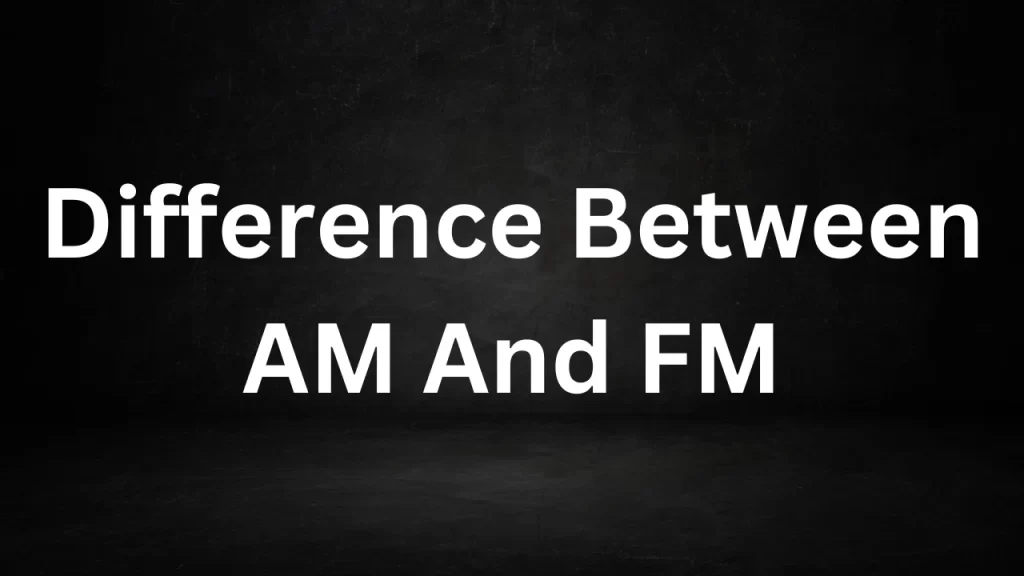Difference Between AM and FM: AM (Amplitude Modulation) and FM (Frequency Modulation) are two common methods used for transmitting information through radio waves.
They differ in how they encode and transmit signals. Here’s a comparison of the key differences between AM and Frequency modulation:

Difference Between AM And FM
Modulation Technique:
AM: In AM, the amplitude (strength) of the carrier wave varies in proportion to the instantaneous amplitude of the modulating signal (e.g., audio signal). This means that the amplitude of the carrier wave is modulated to carry the information.
FM: In FM, the frequency of the carrier wave varies in proportion to the instantaneous frequency of the modulating signal. In other words, the frequency of the carrier wave changes as it carries the information.
Sensitivity to Interference:
AM: AM signals are more susceptible to amplitude variations due to interference, such as atmospheric disturbances and electrical noise. This can result in audible static and interference.
FM: Frequency modulation signals are less sensitive to amplitude variations but are more sensitive to frequency variations. As a result, they are generally less prone to interference, providing clearer audio quality.
Bandwidth:
AM: AM signals have a narrower bandwidth compared to Frequency modulation signals. This means that AM stations can be placed closer together on the radio dial but have a limited audio bandwidth.
FM: Frequency modulation signals have a wider bandwidth, allowing for higher-fidelity audio transmission. However, this wider bandwidth requires Frequency modulation stations to be spaced farther apart on the dial to prevent interference.
Signal Quality:
AM: AM signals are known for their simplicity and are suitable for transmitting voice and news. However, they have lower audio quality compared to FM and are more susceptible to noise.
FM: FM signals offer superior audio quality, making them ideal for music transmission. They are less prone to noise and interference, resulting in clear and high-fidelity sound.
Range and Coverage:
AM: AM signals can travel longer distances and provide better coverage at night due to changes in the ionosphere, which reflects AM signals. This makes AM suitable for long-range communication.
FM: FM signals have a shorter effective range and are less affected by changes in the ionosphere. They are typically used for local and regional broadcasting.
Applications:
AM: AM is commonly used for broadcasting news, talk radio, and voice transmissions, especially in AM radio stations.
FM: Frequency modulation is preferred for music broadcasting, including Frequency modulation radio stations, and is used in applications like two-way radio communication.
In summary, AM and FM are two distinct modulation techniques used in radio communication, each with its own set of advantages and disadvantages. AM is known for its longer range and simplicity, while Frequency modulation offers better audio quality and resistance to interference. The choice between AM and Frequency modulation depends on the specific requirements of the communication system and the type of content being transmitted.
Read More
- Dielectric Material And Dipole Moment
- Difference Between Centre Of Gravity And Centroid
- Kinetic Gas Equation Derivation
- Electromagnetic Waves Transverse Nature Class 10
- Difference Between KVA And KW
Frequently Asked Question (FAQs) on Difference Between AM And FM
What is AM and FM?
AM stands for Amplitude Modulation, and Frequency modulation stands for Frequency Modulation. They are two different methods of modulating radio waves to transmit information.
How do AM and FM differ in modulation technique?
In AM, the amplitude of the carrier wave varies with the information signal, while in Frequency modulation, the frequency of the carrier wave changes with the information signal.
Which has better audio quality, AM or FM?
Frequency modulation has better audio quality compared to AM. Frequency modulation signals are less prone to noise and interference, resulting in clearer and higher-fidelity sound.
Are AM and FM signals equally susceptible to interference?
No, AM signals are more susceptible to amplitude variations due to interference, while Frequency modulation signals are less sensitive to amplitude variations but more sensitive to frequency variations.
Why are AM signals more suitable for long-range communication?
AM signals can travel longer distances due to their ability to bounce off the ionosphere, especially at night. This property makes AM suitable for long-range communication.
